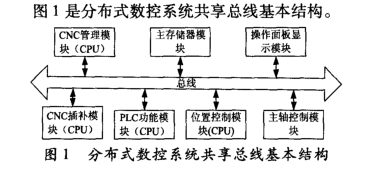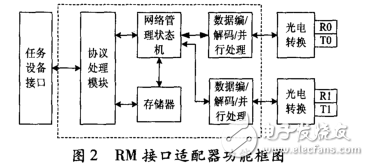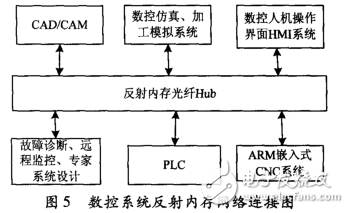With the development of embedded and communication technology, the CNC system has experienced the development process from the traditional single-processor centralized architecture to the open architecture to the multi-processor distributed CNC system architecture. Distributed CNC system takes high-precision and high-speed machining features as the core of development, and at the same time, it achieves the seamless integration of information among heterogeneous networks, realizing the development direction of a new generation of manufacturing systems with high real-time performance, high reliability, and high compatibility. .
For the problem of how to improve the real-time communication capability of distributed CNC systems, Tao Lin et al [1] proposed a real-time communication network based on Ethernet distributed CNC system; Song Zhenjun et al [2] proposed distributed control based on industrial Ethernet. System architecture, although Ethernet technology has the advantages of good stability, low cost, high bandwidth, and excellent compatibility, Ethernet's CSMA/CD (carrier multiple access, collision detection) transmission mechanism determines that it cannot Ensure network transmission delay, resulting in poor real-time performance. Jin Zhenhua [3] proposed a distributed CNC system based on CAN bus. Although various field buses are widely used to connect field devices, they have the advantages of simple wiring, low hardware cost, and accurate and stable operation, but the data transmission rate is low, and real-time performance is not high. The reflective memory network fiber bus not only has a much higher data transfer rate than Ethernet and fieldbus, but also is a real-time, deterministic network that can better solve the problem of real-time data transmission in real-time systems [4 - 5].
Reflective memory technology is used in all applications that connect computers or programmable logic controllers using Ethernet, Fibre Channel or other serial networks, such as real-time flight simulators, telecommunications, high-speed process control (rolling mills and aluminum manufacturing) Plant, high-speed test and measurement systems, but not for all applications [6 - 8]. So reflective memory network is applicable
In a distributed CNC system, how to effectively apply a reflective memory network to a CNC machine tool becomes a key issue in reflective memory network applications. In this paper, based on the analysis of the basic structure of distributed CNC system and the working principle of reflective memory network, a real-time communication network scheme of distributed CNC system based on reflective memory network is proposed. The basic frame structure, node model and development of the system are given. structure. The realization of this structure scheme not only greatly improves the network bandwidth, but also improves the real-time performance of the data transmission of the numerical control system.
1 The basic structure of distributed CNC systemThe distributed numerical control system is the integrated application of the distributed control idea on the numerical control system. With the increase of the functions of numerical control systems and the improvement of the processing speed of CNC machine tools, many CNC systems use a multi-microprocessor structure. Each microprocessor is connected through a data bus or communication, and the common memory and I/O interfaces of the shared system are shared. Each processor shares a part of the system's work [3, 9-11]. In the distributed numerical control system, the signal transmission demands higher and higher real-time performance.

Figure 1 shows the basic structure of a distributed control system shared bus.
2 reflective memory technology2. 1 reflective memory network works
ReflecTIve Memory Network (RNN) is a high-speed real-time network. It is a fiber-connected high-speed shared memory network. Like a typical LAN based on TCP/IP protocol, it also attaches a network card to each node computer. The reflective memory network interface adapter is an interface connected to each task device and a reflective memory fiber network, and has dual functions of data transmission and network management, and is a core device of the entire reflective memory ring network. The RM interface adapter is mainly composed of photoelectric conversion, data encoding/decoding/parallel processing, network management state machine, memory, protocol management module, and task device interface. The system functional block diagram is shown in Figure 2.

Figure 2 RM interface adapter functional block diagram
The reflective memory network is a special shared memory system. Each node occupies a corresponding memory address, and the entire system memory can be independently saved in each node subsystem. A reflective memory card is inserted into each node of the real-time communication network, and the card has dual-port memory. Each layer of software can read and write the memory [12 - 13]. Reflective memory can implement memory-to-memory communications in distributed systems. After the data is written to the memory of a machine's reflective memory card, the reflective memory card FPGA hardware automatically transmits the data to the memory of the reflective memory network node card in other reflective memory networks on the real-time communications network. Usually, only one node is updated less than zero. With a time delay of 4 μs, the transmission traverses all reflective memory cards, and corresponding addresses in all reflective memory network nodes are written into the corresponding data. Therefore, when members of the real-time communication network access data, they only need to access the memory of the local reflective memory card [9, 14 - 15]. A reflective memory node consists of local memory, embedded interfaces, and arbitration logic that provides access to the host and reflective memory. Reflective memory nodes can be installed or connected to different types of computer buses, including VME, PCI/PCI-X. , PCI Express, etc. [4].
2. 2 reflective memory network topology

The reflective memory network is mainly formed by connecting reflective memory cards through optical fibers and other transmission media. It mainly has two physical topologies: a star topology (as shown in Figure 3) and a ring topology (as shown in Figure 4). ). For the reflective memory network of the ring topology, the adjacent reflective memory card forms a ring network through the connection between the input and the output, and the data packet is transmitted along the ring network. The advantage is that there is no need for fiber Hub, the use of fiber is small, and the cost is saved. The disadvantage is that each node has a delay. If any node or fiber fails, the data packet cannot be sent, causing the entire delivery network to collapse. Therefore, a star structure is generally used. In fact, the star topology is only a physical structure, because the internal structure of the hub is a ring connection. Logically, it is still a ring structure [4]. Each node in the network has a unique node ID. In the same network, it is not allowed to have two identical IDs. This ID is set through the dial switch on the board. The smaller the ID number, the higher the priority. When the data source node sends data packets through the hub, the hub can find out the data transfer direction according to the neighboring board's high and low IDs, thereby real-time updating the corresponding data of all the nodes. In a star configuration, if a node is not working, the hub can automatically block the faulty node without affecting the data transmission of other nodes. The disadvantage of the star structure is that once the Hub in the network fails, the entire network will be faulty. 16]. Figure 3 Star topology Figure 4 Ring topology
3 Construction of a Distributed CNC System Based on Reflective Memory Network3. 1 CNC system network construction According to the characteristics of the numerical control system information transmission and the overall transmission requirements, it is proposed to use a reflective memory fiber bus to connect the CNC device, PLC, fault diagnosis expert system, HMI control panel, CAD/CAM, and numerical control processing simulation simulation system components A distributed CNC system. Each task node of the bus network is connected to an RM (ReflecTIve Memory) interface adapter. Each RM interface adapter integrates a dedicated storage space. The system maps the storage space to the address space of the processing system of the network node, so that the node processing system The operation of the RM interface adapter is the same as that of the native memory operation. When the node task device writes data to a location in the virtual address space mapped to reflective memory, the reflective memory network protocol propagates the data to each other node on the network in nanoseconds. And the updated propagation operation is asynchronous, without the intervention of the application system processor. The numerical control system network connection structure is shown as in Fig. 5.

Fig.5 Network connection diagram of reflective memory in CNC system Working process of distributed CNC system: The CAD/CAM system models the parts to be machined and generates NC codes according to the machining process[17]; The NC simulation processing and processing simulation system carries out the generated NC codes. Graphic simulation, pre-processing, detection of abnormal phenomena such as tool interference; HMI (Human Machine Interface) as the input and display unit of the industrial computer is the medium for information exchange between the system and the user, shows the status of various control signals The operator can operate the machine tool through it, set and modify the machine tool parameters, and load the parts processing file; the CNC module receives the processing code transmitted by the upper computer, generates motion control instructions through the interpreter and interpolator; remote monitoring and The fault diagnosis expert system collects the information of the digital control system and the sensor body of the machine tool, remotely monitors the running status of the machine tool, and analyzes the fault cause and fault location of the operating fault. If these functions or systems are installed on a computer, the computer load will increase, and the interpolation process is a highly real-time process. These modules are connected with a reflective memory network, and the exchange of information between them is almost impossible. The time delay is equivalent to a computer-implemented control and can well meet the real-time requirements of CNC machine tools.
3. 2 Reflective Memory Network Communication Process
Since the transmission of the reflective memory network is a pure hardware operation, it is not limited by a specific network protocol, and it does not need to write a complicated interface program. The software can read and write the reflective memory card with only a few lines of code. The entire communication process is as follows: Step1: Open the board and reset the board; Step2: Initialize the board: execute the interrupt initialization function (INT_Init); Set the board interrupt packet interrupt enable (RM_IntDataArrive_IntEnable); Enable the fiber transceiver (RM_FM_Enable) Step3: Communication begins
(1) The sender sends an interrupt (RM_TxIntPkt). After the interrupt is interrupted, the interrupt handler automatically calls the interrupt handler (RM_Rx-IntPkt). The sender sends packets (RM_TxDatPk): When a write operation to the SDRAM is generated, the reflective memory card automatically writes data and other related information (including data address, node number, etc.) to the send buffer in the send buffer. The sending circuit detects and converts the data into a 4- to 64-byte variable-length packet that is sent over the fiber interface to the receiving port of the next board.
(2) The receiver receives the interrupt packet; After the interrupt packet is interrupted, the interrupt handler automatically calls the interrupt handling function (RM_RxIntPkt). Receive data packet (RM_RxDatPkt), write to disk, enable thread function to query the status of receiving data packet (RM_IntStatus), first determine whether this node needs to write data, if not, then directly forward and write interrupt to the next group of internal nodes Otherwise, read interrupts are sent after writing data to the reflective memory card, the receiving circuit unpacks the data and stores the data in the on-board receive buffer. In the receive buffer, another circuit writes the data to The local SDRAM is in the same address as the source node. At the same time, the circuit sends data to the transmit FIFO and repeats this process until the transmitted data is returned to the receiving end of the source node. Then the source node deletes the data with the same node ID from the network, so that all nodes are updated. Repeat the above process. Exit the program and close the board (RM_Card_close).
3. 3 Bandwidth and real-time analysis During high-speed and high-precision machining, the interpolation cycle is generally controlled between 1 and 2 ms. The shorter the interpolation cycle, the closer the straight-line interpolation segment approaches the actual machining curve, and the higher the machining accuracy. For a distributed CNC system, each unit that is relatively independent in geographic location is interconnected through a network communication system. The bandwidth and real-time nature of data transmission can greatly affect the actual processing results.

Table 1 shows the comparison of common network communication methods in several CNC systems. The bandwidth of the emission memory network used in this paper is up to 1. At 06Gbps, the network transmission delay is 400 to 750 ns. Both of these indicators are significantly better than Fiber Distributed Data Interface (FDDI), CAN, Industrial Ethernet, and PROFIUBS fieldbus. Table 1 Comparison of real-time performance of several types of communication networks vs. network type bandwidth RMN 1. The transmission delay determined by the 06 Gbps node is 400 to 750 ns. FDDI 100 Mbps The optical cable delay and station delay make the response time at least >5ms. CAN 1 Mbps The data rate is low, the speed is low, and the general response time is 5 to 10ms. Industrial Ethernet 100 Mbps. CSMA/CD The transmission mechanism determines that it cannot ensure the certainty of the transmission delay, resulting in poor real-time performance. Transmission delay up to 1 to 10 ms PROFIBUS < 12 Mbps response time> 10 ms4
Ending languageIn the field of reflective memory network technology applied to numerical control systems, this paper made a preliminary exploration and proposed a real-time communication network scheme for distributed CNC systems based on reflective memory network. The basic frame structure of the system was given. Node model and extended structure. In practical applications, it may be considered to combine the reflective memory network with Ethernet, use the reflective memory network in the strong real-time part, and use the Ethernet in the weak real-time part to fully utilize the resources and reduce the development cost.
Today let`s talk about touch screen laptop. Sometimes people take Yoga Laptop or 2 In 1 Laptop or 360 Laptop as foldable touch screen laptop. Cause the later ones usually with touch screen function. The difference is that touch screen laptop specials can`t be flipped up to 360 degree, usually 180 degree. Do you think which kind of person love 2 in 1 touch screen laptop more? Business people is the right answer, cause they care more performance, touch screen function, 180 rotating, which are the very important points for businessman, especially teaching in person, do presentation, etc.
Do you think what other business laptop businessman love also except touch screen laptop under 20000? 14 inch 11th Laptop and 15.6inch 11th or 10th Laptop should be the top levels.
As a professional manufacturer, also customizing Android Tablet, Mini PC , and all in one except laptop. So believe you can always get the most competitive one at this store, balancing the quality and cost at top.
Any other special demand, you can just contact us freely. Will try our best to back you up.
Touch Screen Laptop,Touch Screen Laptop Specials,Touch Screen Laptop Under 20000,Foldable Touch Screen Laptop,2 In 1 Touch Screen Laptop
Henan Shuyi Electronics Co., Ltd. , https://www.shuyiaiopc.com